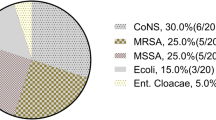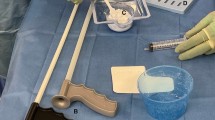Abstract
The treatment of intramedullary infections after nailing usually includes removal of the nail, debridement, and, in some cases, insertion of antibiotic-impregnated cement beads. We use this self-made antibiotic cement rod to treat intramedullary infections. Compared with the beads, it provides some limited mechanical support and can be preserved in the canal for a long time. We reviewed 19 infected patients who underwent removal of the nails, excision of sinus tracks, debridement of the canal and insertion of the rods. No recurrent infection occurred in 18 cases and 11 cases achieved bone healing, 6 cases achieved partial union. One patient had nonunion and one patient underwent amputation because of severe primary trauma and long-term infection. The rod was removed between 35 and 123 days after implantation. We conclude that the antibiotic cement rods could be a relatively effective, simple and inexpensive method of treating intramedullary infections after nailing.





Similar content being viewed by others
References
Patzakis MJ, Wilkins J, Wiss DA (1986) Infection following intramedullary nailing of long bones: diagnosis and management. Clin Orthop 212:182–191
Klemm KW (1993) Antibiotic bead chains. Clin Orthop Relat Res 295:63–76
Raut VV, Siney PD, Wroblewski BA (1995) One-stage reision of total hip arthroplasty for deep infection: long term follow up. Clin Orthop Relat Res 321:202–207
Zych GA, Huston JJ Jr (1995) Diagnosis and management of infection after tibial intramedullary nailing. Clin Orthop Relat Res 315:153–162
Chin CE, Ko JY, Wang JW, Wang CJ (2003) Infection after intramedullary nailing of the femur. J Trauma 55(2):338–344
Tunney MM, Ramage G, Patrick S, Nixo JR, Murphy PG, Goman SP (1998) Antimicrobial susceptibility of bacteria isolated from orthopedic implants following revision hip surgery. Antimicrob Agents Chemother 42(11):3002–3005
Taggart T, Kerry RY, Norman P, Stockley I (2002) The use of vancomycin-impregnated cement beads in the management of infection of prosthetic joints. J Bone Joint Surg [Br] 84(B):70–72
Wininger DA, Fass RJ (1996) Antibiotic-impregnated cement and beads for orthopedic infections. Antimicrob Agents Chemother 40(12):2675–2679
Askew MJ, Kufel MF, Fleissner PR Jr, Gradisar IA Jr, Salstrom SJ, Tan Js (1990) Effect of vacuum mixing on the mechanical properties of antibiotic-impregnated polymethylmethacrylate bone cement. J Biomed Mater Res 24:573–580
Petrisor B, Anderson S, Court-Brown CM (2005) Infection after reamed intramedullary nailing of the tibia: a case series review. J Orthop Trauma 19:437–441
Simpson AH, Cole AS, Kenwright (1999) Leg lengthening over an intramedullary nail. J Bone Joint Surg Br 81:1041–1045
Coles CP, Gross M (2000) Closed tibial shaft fractures: management and treatment complications. A review of the prospective literature. Can J Surg 43:256–262
Joshi D, Ahmed A, Krishna L, Lal Y (2004) Unreamed interlocking nailing in open fractures of tibia. J Orthop Surg (HongKong) 12:216–221
Ueng WN, Shih CH (1992) Management of infected tibial intramedullary nailing using an organized treatment protocol. J Formos Med Assoc 91:879–885
Klemm KW, Borner M (1986) Interlocking nailing of complex fractures of the femur and tibia. Clin Orthop 212:89–100
Klemm K (2001) The use of antibiotic-containing bead chains in the treatment of chronic bone infections. Clin Microbiol Infect 7:28–31
Yamamoto K, Miyagawa N, Masaoka T, Katori Y, Shishido Y, Imakiire A (2003) Clinical effectiveness of antibiotic-impregnated cement spacers for the treatment of infected implants of the hip joint. J Orthop Sci 8:823–828
Ohtsuka H, Yokoyama K, Higashi K, Tsutsumi A, Fukushima N, Noumi T et al (2002) Use of antibiotic-impregnated bone cement nail to treat septic nonunion after open tibial fracture. J Trauma 52:364–366
Paley D, Herzenberg JE (2002) Intramedullary infections treated with antibiotic cement rods:preliminary results in nine case. J Orthop Trauma 16:723–729
Smeltzer MS, Thomas JR, Hickmon SG, Skinner RA, Nelson CL, Griffith D et al (1997) Characterization of a rabbit model of staphylococcal osteomyelitis. J Orthop Res 15:414–421
Nelson CL, Hickmon SG, Harrison BH (1994) Elution characteristics of gentamicin-PMMA beads after implantation in humans. Orthoppedics 17:415–416
Miller MF, Ada JR, Webb LX (1989) Treatment of infected nonunion and delayed union of tibia fractures with locking intramedullary nails. Clin Orthop 245:233–238
Author information
Authors and Affiliations
Corresponding author
Rights and permissions
About this article
Cite this article
Qiang, Z., jun, P.Z., jie, X.J. et al. Use of antibiotic cement rod to treat intramedullary infection after nailing: preliminary study in 19 patients. Arch Orthop Trauma Surg 127, 945–951 (2007). https://doi.org/10.1007/s00402-007-0315-x
Received:
Published:
Issue Date:
DOI: https://doi.org/10.1007/s00402-007-0315-x




